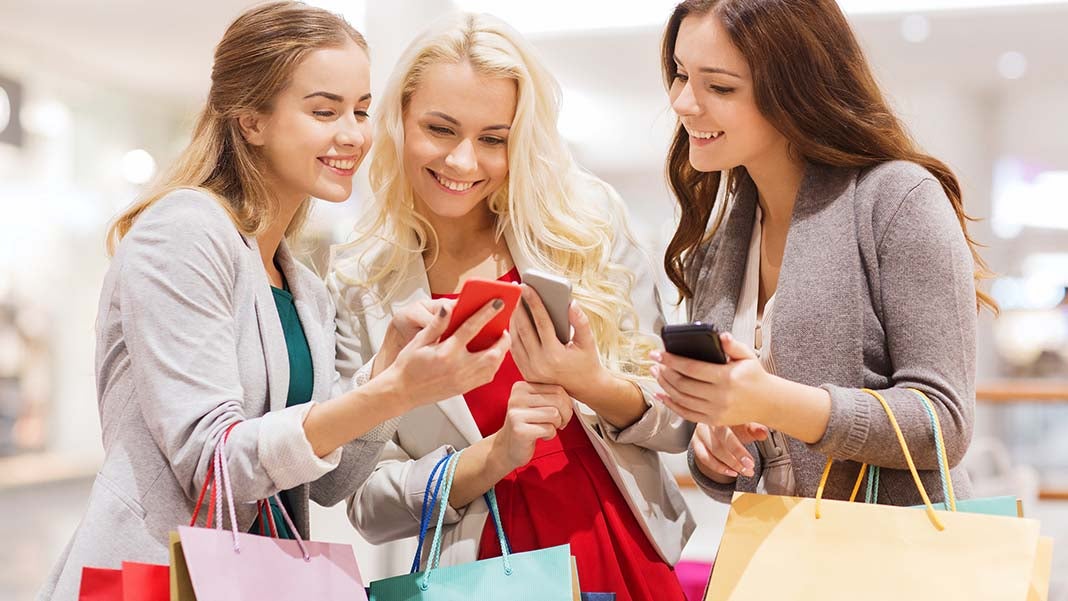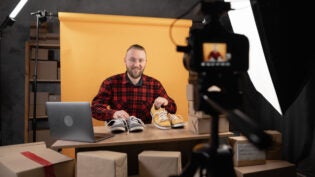
When it comes to digital trends for retail, it seems as if someone is always marketing “the next big thing,” which can often lead to a lot of trial and error. And with retail attempting to make a big comeback this year, there isn’t a lot of wiggle room for technology that doesn’t provide a close-to-immediate positive outcome.
Many retailers pride themselves on staying on top of the latest digital trends, while some are still fighting the installation of chip readers. But regardless of where you land on that graph, the time has come when these trends will be paramount in helping to present a stellar customer experience.
So, let’s look at X digital trends for retail success, provided by industry experts who just can’t seem to live without them!
1. Tier-Based Loyalty Programs
According to Kelly Sykes from Ackroo:
“Now that the digital age has brought in online apps and loyalty card scanners, there’s never been a better time for rewarding your customers for their loyalty. Tier-based loyalty programs place customers into a certain level in your loyalty program. This can change depending on their spending behavior with your business.”
Example: Your loyalty program has 4 tiers (platinum, gold, silver, and bronze). Each of these tiers requires a certain amount of spending in order to hit the next tier level.
You can start your customers off at a bronze tier (for free). Once a customer spends a certain amount to hit the next threshold (silver for this example), they start earning 1.2X back on purchases, rather than the standard 1X percentage back.
The goal of tier-based loyalty is to encourage customers to keep coming back to your business while continually increasing their spending per visit. Make sure to consistently communicate with customers on their account status and balance.
2. Instagram Shop
“As an award-winning digital marketing agency, we are preparing our clients for everything and anything,” says Ashley Regan-Scherf with RGC Advertising. “In sum, the most important Digital Marketing hack we are implementing into our campaign for our retail clients includes Instagram Shop.
No matter what type of products a retailer sells, they should be advertising on Instagram’s New Shop Tab. The future of e-commerce is on this app: with 70% of shopping enthusiasts using Instagram for product discovery and over 130 million Instagram users interact with at least one shopping post every month.”
We live in such an oversaturated and digitalized society; retail brands need to think of social media as new e-commerce websites. They can meet the consumers where they spend most of their time, online!
3. Data-Driven Personalization
“Consumers have come to expect personalized experiences across channels, and brands must continue to implement data-driven personalization into their communications strategy at every level,” notes Darren Litt of Hiya Health. “Brands like Amazon, Starbucks and Netflix get the most from consumer data by creating a customer experience built around the unique personality of each user.
The quest in 2021 continues to be finding innovative ways to merge personalization with segmentation both on a granular level and at scale while addressing a growing concern for consumer privacy. Keeping up with shifts in messaging delivery is another challenge, and machine learning software may be the key to fine-tuning relevancy for targeted personalized B2C campaigns.”
Campaigns that hone in on what really matters to your customer base will continue to build that priceless loyalty needed to maintain a competitive edge. To master personalized messaging you have the power to speak to each unique customer with one process aided by automation.
4. Experiential Marketing
Ali Payani of LookinLA has noticed several retail trends:
“There are many e-commerce factors for the retail industry that businesses should consider for their website and marketing activities. Some businesses such as Ralph Lauren, introduced their virtual store on their website, so customers can have a similar real-life virtual experience although shopping online.
Generally, every business should think of implementing the 4E’s; Experiences, Everyplace, Exchange and Evangelism for their brand. Any brand should have Omni-Channel marketing to be in every place that their customers are visiting and to develop engaging content to entice the customer to learn more about the brand.
Prices and promotions are still playing an important role, but customers don’t just look for low prices anymore, as they are looking for overall better values. It is key that brands ensure that they publish content that represents their brand’s values and mission and always maintain strong communication channels with customers.
What customers are looking for is a new or easy experience in your store. Something that captures their attention and makes them want to purchase or come back at a later time.”
This can apply to your marketing strategy as well, such as implementing an Experiential Marketing campaign, similar to those seen on YouTube by companies like Pepsi, Nivea and Lipton. The virtual store designed by Ralph Lauren is also a prime example of the implementation of Experiential Marketing for your store where people will fully engage with a brand’s products and then share their experience with friends and family.
5. Digital Mapping
Andre Belisle of JL’s Home Hardware Building Centre, has been a customer of a startup called Spot It before the pandemic for an in-store kiosk solution.
“They are a digital mapping company so when I had to turn off the kiosk to prevent the spread of COVID, they provided a map of my store that could be sent out to shoppers. They then launched a platform that had multiple local stores mapped out, and I jumped at the opportunity to have my store map there as a way to help my shoppers.
This online platform allowed shoppers to search for items in my store and see where sales were located. Another added bonus was that shoppers could plan their trips before they ever stepped foot in my store. With a more convenient in-store shopping experience, we continued to demonstrate that we were doing everything possible to ensure their safety. It had an added benefit in that the shoppers that used this tool didn’t need to ask my employees for help to locate items. Essentially, it saved me money while shoppers still had a great and improved experience. All of this was possible without having to integrate with a central infrastructure.”
6. Artificial Intelligence and Machine Learning
Nathan Sebastian, who works with GoodFirms, has realized that iImplementing artificial intelligence and machine learning allows effective segregation of customers, which has been made affordable for new players through wide-scale use by eCommerce giants.
“Analyzing a user’s entire journey as a consumer, future decisions can be influenced by personalized promotions based on behavioral patterns and decisions. This allows individual targeting with high effectiveness instead of mass targeting with low returns.”
7. A/B Testing
“To increase conversion rates, it is essential to A/B test faster than all your competitors,” advises Ray Blakney of Live Lingua. “Constantly be testing and improving every step of your sales funnel. Test and tweak your marketing emails to improve open and click-through rates. For your website, constantly test new copy on your landing pages. The faster you can test, the faster you will find the best results, and the faster your business will grow.”
8. Famous
On March 2, Famous launched a new no-code platform for creating 100% customized and immersive mobile shopping experiences. Bob Brahan says, “This platform, which can be compared to a Canva-type solution for mobile websites, will help brands and merchants tell their unique story and give them a competitive edge in the crowded e-commerce space.”
9. Spinlister
Colby Marple noticed that prior to the pandemic, online reservations were already becoming the preferred “step one” for e-commerce consumers. However, in the outdoor industry, these solutions were not being used at scale to match the changing demands for consumers.
“Today, it’s more important than ever to bring your business directly to customers via Zoom — or if a customer does leave home, they need to be assured of meeting with a sales associate,” he says. “Spinlister, an innovative appointment tool, enables e-commerce retailers to create personalized shopping experiences that are far more effective than going back and forth via chat or email.”
10. AR-Powered Shopping Experience
In Maulik Patel of Click Matix’s opinion, the most notable digital trend for retail success is the AR-powered shopping experience.
“Augmented reality (AR), artificial intelligence and (AI) machine learning are here to stay. According to a survey, customers listed Augmented and Virtual Reality as the topmost technologies they’re asking to help them in their daily lives, with 51% saying they would be more than happy to use AR technology to evaluate products.”
As a lot of shoppers continue to rely on online shopping, retailers support AR technology to connect the gap between the physical and the digital.
And according to Yuliya Andreyuk of Banuba, 40% percent of shoppers would be willing to pay more for a product if they could experience it through augmented reality (AR).
“Trying out eyewear, nail polish, clothing, etc. before buying is already widespread and used by brands like Gucci and Sally Hansen. Fortunately, this technology is now widespread and affordable even for SMEs. Retailers can use AR-enabled apps and ‘smart mirrors’ to make shopping more fun for both offline and online buyers and increase sales as a result.”
Jack Zmudzinski of Future Processing adds, “It’s going to be all about AR and AI. It’s incredible how quickly these things have gone from ‘interesting concept’ to ‘essential’ for many retailers; particularly during the past year when our entire lives have been online. In 2019, 51% of consumers said that they would happily access products using AR, and I imagine that figure is significantly higher now. Top brands like Ikea, Home Depot and Target already use proprietary AR shopping experiences, and I see this rolling out rapidly to smaller brands in 2021.”
11. Digital Signage
“More retailers are adopting digital signage to improve customer experience or communications,” mentions Alistair Cousins of TrouDigital. “A highly popular trend is adopting interactive digital property catalogs. Customers can use the screen to browse stock, etc. When they find a product they like, they can have it shipped directly home, or request to collect it at the counter.
Retailers are also moving away from using posters to advertise their latest products. Digital signage software is also helping larger retail chains work more efficiently. Thanks to cloud-based digital signage, retailers can update a large network of screens in multiple locations in seconds.”
Retailers can also schedule marketing campaigns to go live on certain dates, which is perfect for holiday promotions etc. This was simply not possible with traditional methods such as posters, which took a lot of time and money to constantly replace and update.
12. Social Commerce
“There’s no doubt that retail is changing rapidly,” notes Milosz Krasinski with Chilli Fruit, “And this began before the pandemic and has accelerated sharply since. In my opinion, the biggest trend for 2021 is going to be social commerce. While this was already rumbling along in the past few years, partnerships such as the one between Tik Tok and Shopify have solidified this. These days, customers want instant gratification, and being able to shop products directly from Facebook and Instagram without being redirected to the retailer’s site will be huge this year.”
This is great for customers and super great for businesses who are able to personalize their targeting and take advantage of impulse purchase decisions directly from their social media platforms.
13. SMS Messaging
“Typically, 90% of text messages are opened within the first three minutes after being received,” states Matt Thompson of Soprano Design. “Due to the high success rate, SMS messages from retailers generate responses when delivering time-sensitive communication to inform or drive spending on their site. Not only does direct communication with customers create a point of difference that drives up engagement, but it also creates a virtual experience that shoppers are missing from not being in a store.”
And Nick Drewe of WeThrift is noticing brands have a lot of success with text clubs. “Create a compelling opt-in — typically 15-20% off a purchase — and you’ll get direct access to the device your customers have in their hands most of the day. The open rate is much higher than an email because the notification is instantaneous, and many people read their texts immediately. Continue to send compelling offers to drive sales. Just be mindful of the frequency to avoid opt-outs.”
In the end, the most important thing is that retailers are open to embracing new technological trends. Whether they will help save a few hours each week or supply a better customer experience, taking a little time to explore and experiment with these trends can be a catalyst for business growth.
7486 Views












